Each year, Blind Employment Awareness Day (BEAD) presents a unique way for individuals and organizations to come together with a shared goal: to increase meaningful employment opportunities for those who are blind or visually impaired.
This is especially important because today, 70% of working-age adults reporting significant vision loss are currently unemployed. As a result, 30% of this population is reported as living below the poverty line. We’re often asked, “What can we do to help?” Here’s some advice on how to partner with us as an advocate for blind employment awareness.
Spreading Hope Through Awareness
The good news is there’s still hope. The first step to improving current workforce conditions is raising awareness around the employment barriers for those who are blind and visually impaired. Although each situation and story is unique, we find that the most common barriers can generally be categorized by transportation, training needs, and lack of accommodations.
While these are real and present challenges, we know there’s power in creating partnerships and sharing resources. It all starts with a conversation. We encourage you to ask your organization what they’re doing to make your workplace accessible and see if you can take steps to improve the experience for your blind or visually impaired employees and customers. BEAD is a great way (and a great day) to get started!
Training and Equipping Teams for Success
When it comes to training and equipping employees to succeed, knowing which tools are both needed and available is half the battle. One of our favorite things to do is to sit down with individuals and have open conversations so we can identify their specific, unique needs and goals. Once we understand this, we can train and equip with the right assistive technology tools to help meet and achieve these goals.
And that doesn’t just stop with IBVI employees. Because for people impacted by blindness or a visual impairment, assistive technology makes inaccessible tasks possible. And, in equipping people with the skills and abilities they need to succeed, it increases independence, quality of life, and sense of self-worth while allowing them to be competitive in the job market.
Getting Your Organization Involved
We stand with and appreciate those who are committed to hiring individuals with vision loss, and who recognize the benefits of having a diverse staff. Providing equitable and meaningful employment opportunities for people with visual impairments benefits employers because it adds great value and a different perspective both to places of employment and the community at large.
But don’t just take it from us! Recently, we conducted an employee survey to check in with our employees about their feelings toward BEAD, and to organizations that are looking to diversify their workforce and increase accessibility for workers with visual impairments. Here’s what they had to say:
What about your job gives you the most satisfaction?
Easton: “I love when I’m given a goal that ‘should’ take me a few months, and I finish in a few weeks. Every time I finish nailing up a crate, I know that I did a good job and we hit our goal. From there, we can move onto the next project and keep going. I love working hard for my boss and for this team, and it gives me joy knowing that I do the best I possibly can with what I have.”
Mel: “I enjoy working. I don’t care what they have me do. I just enjoy coming to work and doing any job.”
Maria: “Working with people. The day-by-day interaction with our customers—whether face-to-face, over the telephone, or even shipping out a box. To me, it is very pleasant.
Is there a job you aspire to do in the future? What would help to get you there?
Easton: “My dream goal is to manage the Falls location and run things. I believe I’m on the right track now, and all it’s going to take is more time and learning. I’ve had a great start these past few years, going from being a tool kitter to a production lead. In my mind, I know I want to run this building because I want to do nothing but succeed for IBVI.
Do you have any advice for companies interested in tapping into the blind and visually impaired workforce? In other words, what can they do to make themselves a more attractive place for those who are blind or visually impaired to work?
Mel: “Stop and consider it, and give those that are visually impaired a chance. They’ll be surprised at everything we can do!”
Easton: “If companies are interested in hiring employees that are blind or visually impaired, they should be ready to offer the accommodations that they might need to help them do their jobs. I think it’s a great way to help somebody get started, but just remember that everybody has a special unique sense of sight. It’s just a matter of if the company can help provide the accommodations or the right guidance for the person. I would also suggest to be patient and be willing to work with them even when it gets tough, because when the going gets tough, the tough get going!”
Maria: “ I would recommend providing accessibility in technology and training, and to give them an opportunity to have a career. Also, I’d say to view the blind or visually impaired as a “person” who is capable of doing things in a different way.”
If you’d like to get involved, we’d love to connect with you! Fill out the Contact Us form on our website and we’ll have someone reach out to you to provide more resources. Thank you for being a part of our mission to employ and empower those who are blind or visually impaired.


